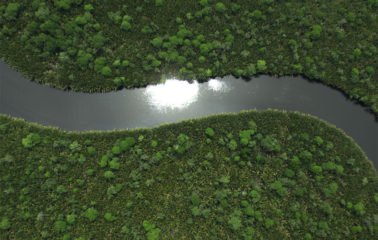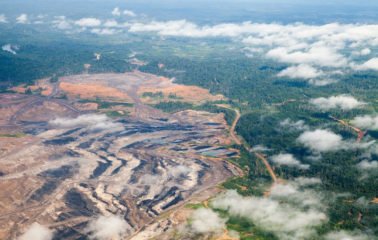In order to save the environment, they bravely move the society to fight for their rights. They fight and survive although they have to hide, threatened to be killed, even to be thrown to container for human waste.
1. Loir Botor Dingit
Rattan farmer of Dayak Bentian – East Kalimantan
Awardee of Goldman Environmental Prize 1997
Moving all indigenous people of Dayak Bentian (male and female) to fight for their basic rights that were violated by Wood Corporation that destroyed indigenous forest.
- Since 1986, Loir and indigenous people of Dayak Bentian (male and female) petitioned to the Government of Indonesia to issue land ownership certificate for indigenous forest area.
- 1993: a company displaced some area of rattan forests and graveyard of Dayak Bentian ancestors.
- 1994 he led people of Dayak Bentian (male and female) to meet Ministry of Transmigration of the Republic of Indonesia in Jakarta. The result was public statement from the Ministry about the need to respect the rights of ethnicities in Kalimantan.
- 1996: Ministry of Forestry of The Republic of Indonesia started the pilot project for the management of 10.000 hectare forests by local people (male and female).
- 1996: he was chosen as the Leader of Dayak Bentian Indigenous Council.
2. Yosepha Alomang
Midwife and woman figure of Amungme – Papua
Awardee of Goldman Environmental Prize 2001
Organizing people opposition in Papua (male and female) for the world biggest gold mining operation.
- Since she was younger: she was an orphan and she lived nomad with other villagers.
- 1977: her 3 year old oldest child died from starving.
- 1991: she did a strike for 3 days in Timika Airport by putting on fire on the airstrip as the symbol of refusal on foreign corporation and protest for the Government of Indonesia.
- 1994: she was arrested and accused of helping the organization of Independent Papua (Organisasi Papua Merdeka), and then she was locked in container for human feces for a week.
- 1996: she filed a civil suit for US Corporation and demanded compensation for local people (male and female) for the damaged environment.
- 1999: she got the award of Yap Thiam Hien from Yayasan Pusat Studi Hak Asasi Manusia.
- 2001: she established Yayasan Hak Asasi Manusia Anti Kekerasan or Anti Violence Human Rights Foundation (YAHAMAK).
- 2001: she used the compensation money from the US corporate to build health center, meeting hall, orphanage, and the monument of Human Rights Violation.
3. Samuel Oton Sidin
Pastor – Pontianak, West Kalimantan
Penerima Kalpataru 2012 kategori Pembina Lingkungan
Awardee of Kalpataru 2012 on the category of Environment builder.
Giving the idea and maintaining environment preservation area through religious approach.
- 2000: he was involved in the establishment of Rumah Pelangi (Rainbow House), forest conservation (arboretum) and preservation area owned by Ordo Fratrum Minorum Capuccinorum (OFM Cap) community.
- 2000s: he did the reforestation on Bukit Tunggal (the area around Rumah Pelangi) to preserve the forests.
- 2000s: he built Catholic Kalvari Church along with simple houses, dams, rice paddies, and ring road around the hill.
- Until now, the activity of Rumah Pelangi includes the assistance for local people around the forests (male and female), growing fruits and rare plants in dry land, and also the preservation of forests and swamp.
4. Aleta Baun
Indigenous woman of Mollo – East Nusa Tenggara
Awardee of Goldman Environmental Prize 2013
Moving the people (male and female) to fight for Mollo indigenous rights that were violated by marble mining on mount Mutis, Timor, NTT.
- Since she was younger, she lost her mother and was taken care by her foster parents who taught her to love the environment as the basic spiritual.
- 1980s: Local Government launched the operation permission of marble mining company without consulting with local people (male and female). As an adult, she pioneered the movement resisting the marble company until she was threatened to be killed many times and should have hidden in the jungle with her baby.
- 2000s: she moved 150 women to occupy the marble mining company sites by living on the marble stones for a year.
- 2010: her struggle succeeded in forcing the marble mining company to stop its operation in indigenous area of Mollo.
5. Rudi Putra
Biology researcher – Aceh
Awardee of Goldman Environmental Prize 2014
Gathering support from national and global public through media daring to resist illegal palm plantations around Leuser Ecosystem Area (Kawasan Ekosistem Leuser (KEL)), Aceh.
- Since younger, he fell in love with biology science and actively involved in the preservation of Javanese Rhino.
- As he grew as an adult, he realized that the habitat demolition of flora and fauna by palm industry affected to whole organism, including human.
- 2006: he actively voiced land protection, representing the voice of Tsunami’s victims.
- 2011: President of Indonesia launched palm moratorium, but deforestation still happened because of illegal logging. Since then, Rudi watched reforestation team that chopped down the palm trees in KEL.
- 2013: he gathered daring petitions to the Government of Indonesia related to conservation policy until he has reached the support of 1.4 million people.
- 2014: he succeeded in closing down 26 illegal palm plantations, 24 of them were closed voluntarily by the owner.
6. Petrus Asuy
Indigenous figure of Dayak Benuaq – East Kalimantan
Awardee of Equator Prize (UNDP) 2015
Moving indigenous people of Dayak Benuaq (male and female)to fight for indigenous forest which was violated by palm plantations company.
- 1971: a palm plantation company got the concession and started to erode the indigenous forests.
- 1993: one of the sub-districts areas became the concession area of coal mining.
- Since 1995, he had moved the indigenous community of Dayak Benuaq (male and female) in Muara Tae, sub-District Jempang, District od West Kutai to keep on fighting for the forests area that was taken away by the company.
- 2015: the area of indigenous land left was 4.000 hectare, decreased from the previous of 12.000 hectare in 1971.
What can we learn?
That forests and land is the nature’s inheritance we should preserve.
How to do that?
Through the implementation of Wilayah Kelola Masyarakat (WKM) system or the Community Management Area System.
What is WKM?
Tata Kelola Hutan dan Lahan (TKHL) or forest and land governance involving indigenous people and or local people (male and female) to determine the policy in environment preservation.
Why the people should be involved?
Because the people (male and female) have the understanding and high sense of belonging towards forests and land where they lived in for generations.




